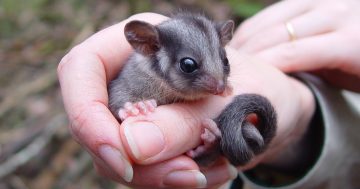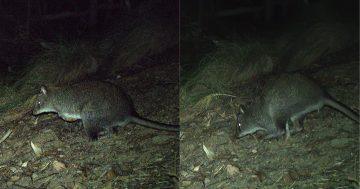
A new species of wraparound spider was found in the Australian alpine region during the Bush Blitz species discovery expedition. Photos: Joseph Schubert.
An 11-day expedition to discover new species in Australia’s Alpine region has uncovered three new species of spider previously unknown to science.
A warrior huntsman with a shield on its chest, a tiny three-millimetre jumping spider that looks like a liquorice allsort, and a wraparound spider that impersonates a tree branch were discovered as part of the Australian Alps Bush Blitz species discovery expedition in February.
Bush Blitz – a partnership between the Australian Government and Parks Australia, BHP and Earthwatch Australia – organises expeditions to document plants and animals across Australia.
The Alps Bush Blitz was the program’s 47th expedition and boasted 15 scientists including botanists and zoologists from Parks Australia’s National Seed Bank in Canberra, the Australian Museum, Museums Victoria, the National Herbaria of NSW and Victoria and the University of New South Wales.
Acting Bush Blitz manager Kate Gillespie said the team were based in Jindabyne and focused their key surveillance around Kosciuszko National Park’s Pilot Wilderness Area near the NSW-Victoria border.
Museums Victoria Research Institute arachnologist Joseph Schubert, who discovered the new spiders, said most people associate spiders with the outback dunny door.
“Many of Australia’s spiders are undescribed – they are unnamed, unknown, undocumented and invisible to the government, industry and community,” he said.
But, he said, as a species they were hugely diverse.
“From the infamous shield huntsman with war paint on his legs and a shield on his chest to frighten off predators to tiny jumping spiders that look like eight-eyed puppies, then there’s the wraparound spider – a ferocious nocturnal mini-hunter that impersonates a tree branch during the day to hide from predators,” he explained, adding “they’re also experts at camouflage”.
Discovering and documenting undescribed species, he said, was crucial for their conservation and may prevent ‘invisible’ species from becoming extinct before they are even documented.

Museums Victoria Research Institute arachnologist Joseph Schubert discovered the three new species of spider during a Bush Blitz expedition in Kosciuszko National Park.
“If a species is not known, it cannot be adequately protected,” Mr Schuman said.
Federal Environment and Water Minister Tanya Plibersek said the discovery of three new spiders in the Australian Alps was fantastic. “Around three-quarters of Australia’s biodiversity is still waiting to be discovered by science,” she said.
“Programs like Bush Blitz are giving us a deeper understanding of Australian habitats so that we can make nature positive decisions for the future,” she added. “Congratulations to Joseph Schubert and the team for their exciting finds.”
Five science teachers also took part in the expedition. They were selected to participate in the Bush Blitz Teach Live program, which allows teachers to work as field assistants during expeditions.
The opportunity allowed them to bring the expedition directly into the classroom in real time via a dedicated website.
Since Bush Blitz’s inception in 2010, it has discovered over 1850 new plant and animal species including frogs, reptiles, fish, spiders and insects.
Ms Gillespie said, at this stage, scientists were still working with the material they collected on the Australian Alps expedition to identify other species and if any more were actually new to science.











